Adaptive tech helps stroke survivors regain independence by offering tools like mobility aids, communication devices, and smart home systems. You can use braces, canes, or motorized wheelchairs to move with confidence. Speech-generating devices and eye-tracking tech boost your ability to communicate. Smart home automation and wearable sensors monitor your health and simplify daily tasks. Exploring these innovations can empower you to live more freely—continue to discover how these technologies can support your journey.
Key Takeaways
- Mobility aids like customized wheelchairs, braces, and lightweight prosthetics restore movement and independence.
- Speech-generating devices and eye-tracking systems facilitate communication without speech.
- Smart home technologies enable remote control of appliances, lighting, and security for safer living.
- Wearable sensors monitor vital signs and activity levels, supporting recovery and early complication detection.
- Virtual reality and mobile apps provide personalized rehabilitation exercises to improve motor and cognitive skills.
Mobility Aids and Assistive Devices

Mobility aids and assistive devices play a crucial role in helping stroke survivors regain independence and improve their quality of life. These tools support your movement, balance, and stability, making daily tasks more manageable. Walkers, canes, and rollators provide steady support, reducing the risk of falls and giving you confidence to move around freely. Wheelchairs and mobility scooters enable longer distances when walking becomes difficult. Adaptive footwear and braces help correct gait issues and provide extra stability. Choosing the right device depends on your specific needs, strength, and mobility level. Proper use of these aids can boost your confidence, encourage independence, and help you participate more actively in everyday activities. With the right support, you regain control over your mobility and daily life. Additionally, understanding the contrast ratio of your visual aids can enhance your visual clarity and overall experience.
Speech and Communication Technologies
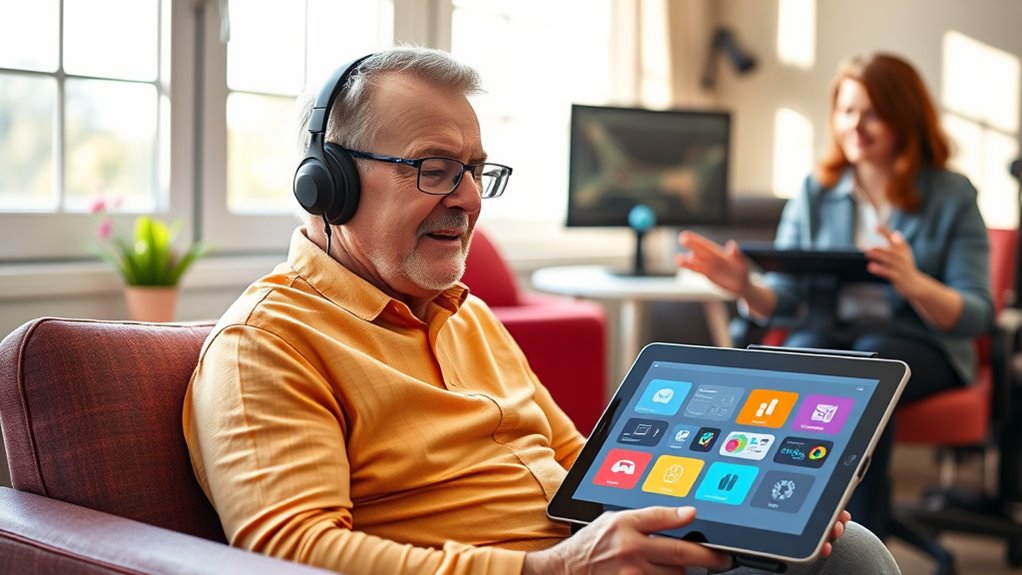
When speech and communication become challenging after a stroke, technology offers powerful tools to help you reconnect and express yourself. Speech-generating devices, such as tablets with specialized apps, enable you to communicate through text-to-speech functions. Eye-tracking technology allows you to select words or phrases if speech is difficult, giving you independence in conversations. Augmentative and alternative communication (AAC) devices provide symbols, pictures, or text to help you express needs and thoughts clearly. Voice therapy apps can support your recovery by guiding exercises that strengthen your speech. These tools are customizable, so you can choose what works best for your abilities. Recognizing the profound impact of these devices can motivate you to explore options that fit your needs. Understanding individual responses to communication difficulties can help tailor the most effective support strategies. Incorporating dynamic communication exercises into your therapy can further enhance your confidence and skills. Utilizing assistive communication technology can also help you adapt to changing abilities over time. With these technologies, you regain confidence and maintain social connections, proving that communication barriers can be overcome with the right support.
Smart Home Integration for Daily Living
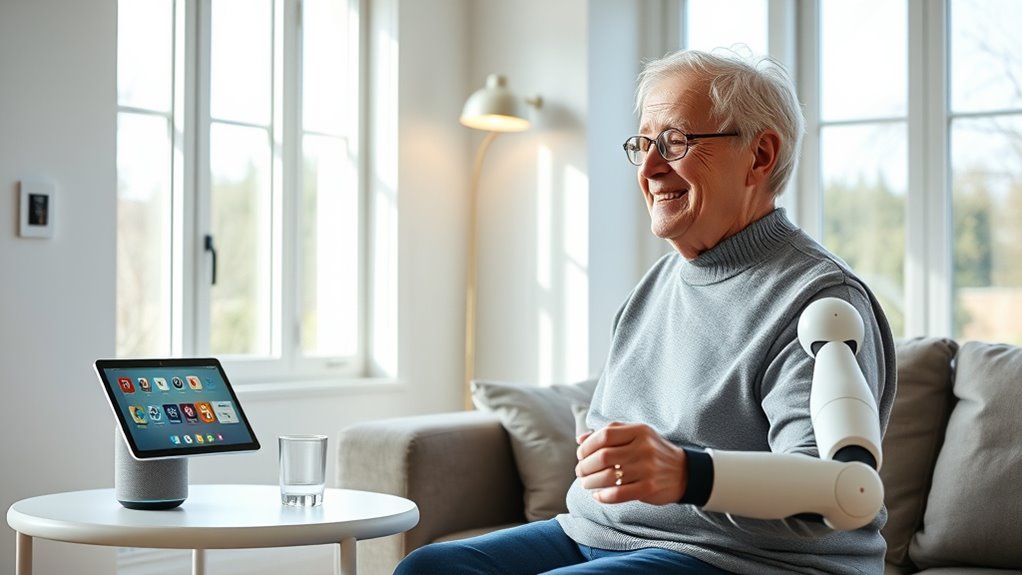
Smart home technology can substantially enhance your independence by making daily routines easier and more manageable. With smart devices, you can control lights, thermostats, and appliances using voice commands or smartphone apps. Automated systems can turn off lights or adjust temperatures when you forget, reducing your need for help. Motion sensors and door sensors can alert you to movement or potential hazards, increasing safety. Smart locks allow keyless entry, so you don’t need to carry keys or worry about losing them. Integration with virtual assistants enables you to set reminders, check weather updates, or get news updates hands-free. These tools work together to create a safer, more accessible environment, empowering you to manage your home and daily tasks with confidence and independence. Additionally, market dynamics indicate an increasing adoption of smart technology, making these solutions more accessible and affordable. Smart home adoption is also supported by ongoing innovations and a growing number of compatible devices. The user-friendly interfaces of many smart devices further facilitate their use by individuals who may have limited mobility or dexterity. It is also worth noting that data-driven strategies can help in customizing these systems to better suit individual needs, thus enhancing their effectiveness. Transparency about affiliate relationships can also support the availability of these innovative solutions at no additional cost to you.
Eye-Tracking and Head-Controlled Interfaces
Eye-tracking and head-controlled interfaces empower stroke survivors to interact with technology independently, even when traditional input methods are challenging. These systems use cameras to monitor your eye movements or head positions, translating your gaze or head motions into commands. With this technology, you can control computers, tablets, or communication devices without needing to use a keyboard or mouse. For example, by simply looking at icons or moving your head in specific directions, you can select options, type messages, or navigate interfaces. This hands-free approach reduces frustration and increases autonomy, allowing you to communicate more easily and perform daily tasks with less assistance. Incorporating adaptive furnishings that are easy to handle can further enhance independence during meal times. As these interfaces become more advanced and affordable, they’re transforming the way stroke survivors regain independence. Facilitating remote collaboration through such assistive devices also opens new avenues for support and social interaction. Understanding the state-specific tax laws can help optimize financial planning related to assistive technology expenses or withdrawals. Additionally, integrating assistive technology with other adaptive devices can create a more seamless and empowering experience for users.
Wearable Devices for Monitoring and Support
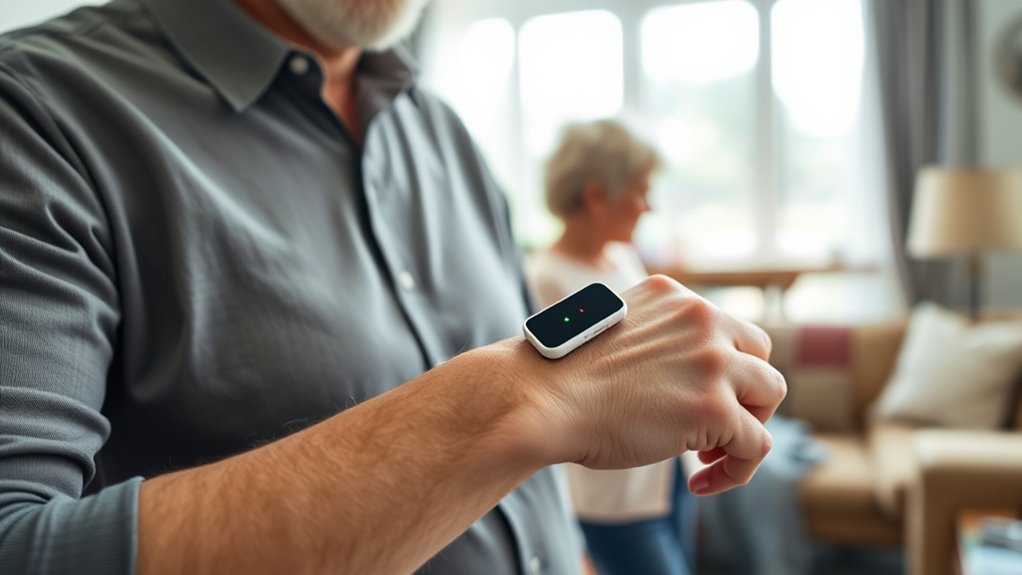
Wearable devices play an essential role in monitoring your health and providing real-time support as you recover from a stroke. These devices track vital signs like heart rate, oxygen levels, and activity patterns, helping you and your healthcare team stay informed. They can detect early warning signs of complications, prompting timely intervention. Additionally, wearables encourage mobility and daily activity, which are key for recovery. You might find features such as ECU tuning that optimize device performance and accuracy, ensuring reliable health data collection. Incorporating proper calibration further enhances the precision of these measurements, supporting more effective monitoring. Regular updates and firmware improvements can also maintain the device’s performance reliability, ensuring consistent and accurate data over time. Furthermore, understanding the health benefits of various fruit juices can complement recovery by promoting overall well-being and nutritional support. Proper maintenance and attention to device battery life are also crucial for continuous monitoring and safety.
Customized Prosthetics and Orthotics
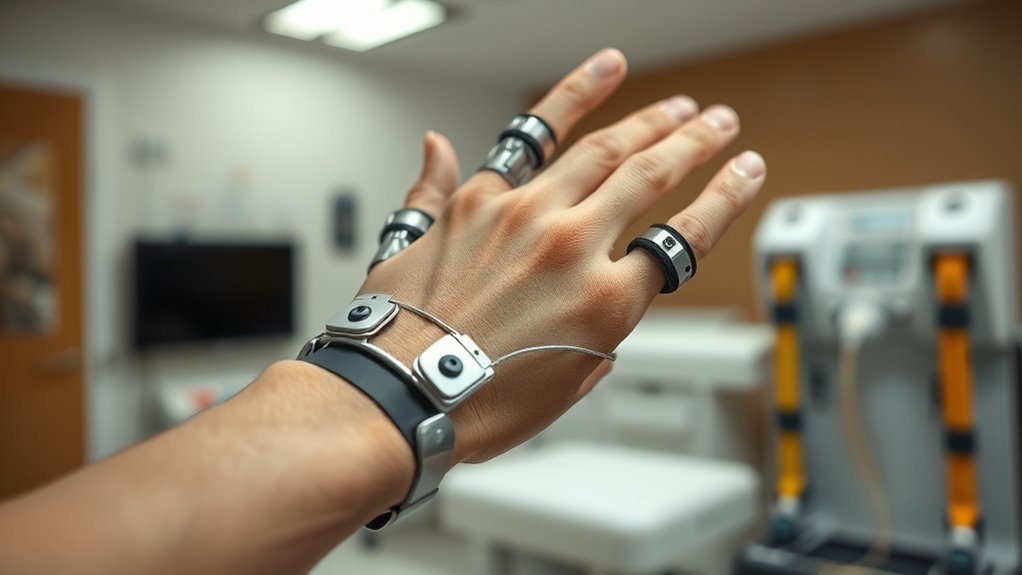
Have you ever wondered how customized prosthetics and orthotics can transform your recovery after a stroke? These tailored devices provide precise support, improving mobility and reducing discomfort. Advances in technology mean your prosthetic can be designed to match your unique anatomy, offering better function and comfort. Orthotics can now be personalized with materials that adapt to your daily activities, promoting independence. Here’s a quick look at some key features:
| Feature | Benefit |
|---|---|
| 3D Printing | Precise fit, faster production |
| Sensor Integration | Real-time feedback for adjustments |
| Lightweight Materials | Easier movement, less fatigue |
| Custom Alignment | Improved posture and gait |
| Aesthetic Design | Boosts confidence and motivation |
These innovations ensure your device supports your specific needs, making daily tasks easier. Innovative design plays a crucial role in tailoring devices to individual lifestyles and preferences. Additionally, personalized support helps optimize recovery and functional outcomes for stroke survivors. To achieve the best results, integrating advanced manufacturing techniques like 3D printing allows for more precise and comfortable prosthetic fitting. Moreover, understanding lifestyle factors can help in choosing the most suitable device features for long-term success.
Furthermore, understanding the cultural context of each individual can influence design choices, ensuring greater acceptance and comfort with the device.
Virtual Reality and Simulation Therapy
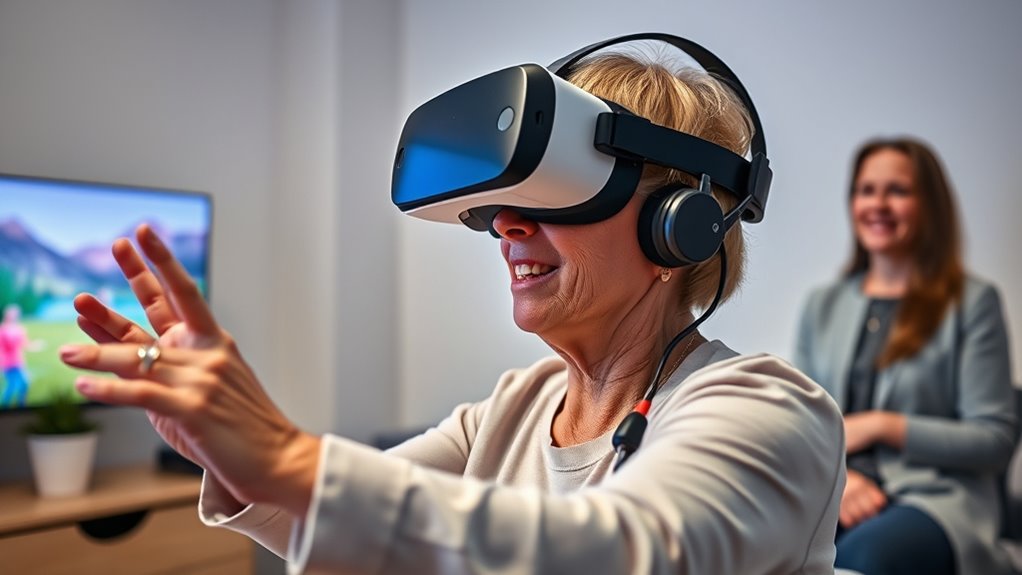
Virtual reality and simulation therapy are transforming stroke rehabilitation by immersing you in interactive environments that promote motor and cognitive recovery. These tools make therapy engaging and realistic, helping you regain movement and improve focus. As you participate, you can:
- Practice daily tasks in a safe, controlled setting
- Receive instant feedback to track progress
- Enhance motivation through gamified experiences
This technology customizes exercises to your specific needs, making therapy more effective. Virtual environments can simulate real-world scenarios, helping you rebuild skills necessary for independence. Plus, engaging with these simulations often leads to faster recovery and better outcomes. Whether you’re working on fine motor skills or cognitive functions, virtual reality offers a dynamic, immersive way to make progress. It’s an innovative step toward empowering stroke survivors to regain control of their lives.
Mobile Apps for Rehabilitation and Skill Building

Did you know that mobile apps are now playing a crucial role in stroke rehabilitation? These apps offer personalized exercises and real-time feedback, helping you regain motor skills and improve daily functioning. They often include interactive games and tasks designed to challenge specific muscle groups, making therapy engaging and accessible from your home. Many apps track your progress over time, allowing you and your healthcare team to adjust your treatment plan effectively. Some also provide educational content to help you understand your condition better. With user-friendly interfaces, these apps empower you to take an active role in your recovery, fostering motivation and consistency. Mobile apps make rehabilitation more flexible, convenient, and tailored to your individual needs.
Future Innovations in Adaptive Technology

As technology continues to advance, innovative solutions are emerging to further enhance stroke rehabilitation. Future innovations aim to make recovery more personalized and accessible. You might see smarter robotic exoskeletons that adapt in real-time to your movements, helping you regain strength more efficiently. Wearable sensors could monitor your progress continuously, providing instant feedback and tailored exercises. Additionally, AI-powered virtual therapists may become common, guiding you through therapy sessions remotely with personalized suggestions. These advancements could also include augmented reality systems that create immersive environments for practicing daily tasks. Overall, the future of adaptive technology promises to empower you with more effective, engaging tools that support independence and recovery after a stroke.
Frequently Asked Questions
How Affordable Are These Adaptive Technologies for Most Stroke Survivors?
You’re wondering how affordable these adaptive technologies are for most stroke survivors. Costs can vary widely, but many options are becoming more accessible as technology advances. Some devices are covered by insurance or assistive programs, reducing out-of-pocket expenses. While some high-tech solutions might still be pricey, there are affordable alternatives and community resources available that help stroke survivors gain independence without breaking the bank.
What Training Is Needed to Effectively Use These Advanced Devices?
To effectively use these advanced devices, you’ll need proper training. Start with understanding the device’s features and functions through manufacturer tutorials or specialized training programs. Practice regularly to build confidence and proficiency. Some devices might require working with a therapist or specialist to customize settings and guarantee safe use. With dedicated effort and guidance, you’ll gain the skills needed to maximize independence and improve daily life.
How Do These Technologies Adapt to Individual Stroke-Related Impairments?
Think of these technologies like a tailored suit, fitting your unique needs precisely. They adapt to your stroke-related impairments by using sensors and algorithms that monitor your movements and challenges. This real-time feedback adjusts the device’s support, helping you regain independence. As you work with these tools, they become more personalized, ensuring you get the assistance you need, just like a custom-fit suit that moves perfectly with you.
Are There Specific Age Groups That Benefit Most From These Innovations?
You might wonder if certain age groups benefit more from these innovations. Generally, older adults often gain the most because they face greater challenges with independence. However, younger stroke survivors also benefit considerably, especially with personalized devices that support their specific needs. Technology can be tailored to anyone, regardless of age, helping you regain independence and improve quality of life, no matter your age.
What Are the Long-Term Maintenance Requirements for Adaptive Devices?
You might wonder about long-term maintenance for adaptive devices, and it’s a good question. Typically, you’ll need to keep the devices clean, update software when needed, and replace batteries regularly. Sometimes, parts may wear out or require repairs. Staying proactive with regular check-ups and following manufacturer instructions helps guarantee your devices stay reliable, so you can continue enjoying independence without unexpected interruptions.
Conclusion
As you explore these innovative technologies, remember they’re transforming limitations into possibilities. While a wheelchair offers mobility, a smart home creates independence; a speech device restores conversation, but virtual reality rebuilds confidence. These advances aren’t just gadgets—they’re your allies, blending challenge with hope. Embrace this fusion of science and resilience, where each breakthrough turns obstacles into gateways, empowering you to reclaim your life with strength and independence.









